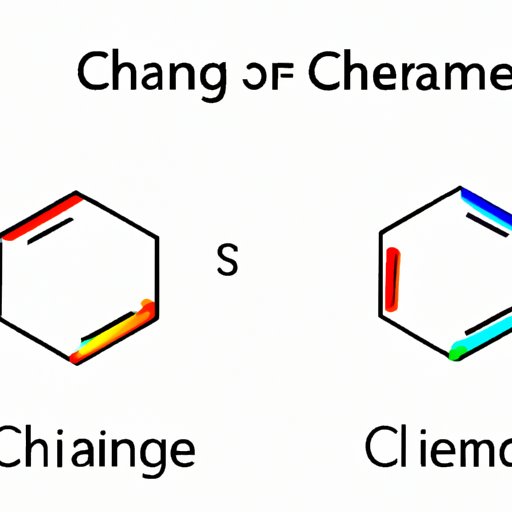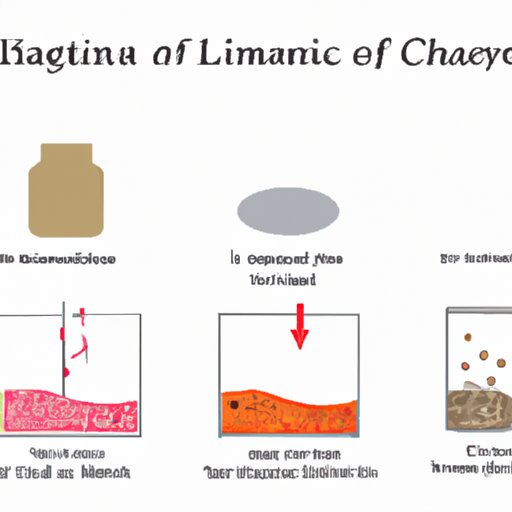
I. Introduction
As we go about our daily lives, we often encounter different substances or materials that change in some way. There are two different types of changes, chemical and physical, which impact our world in various ways. Understanding the differences between these two types of changes is essential since it helps us predict and explain the behavior of matter. This article provides a comprehensive discussion of chemical and physical changes.
II. Defining Chemical and Physical Changes
Simply put, chemical changes involve the rearrangement of atoms and molecules to form new substances or compounds. On the other hand, physical changes refer to a process where matter undergoes a transformation without any alteration in its chemical composition.
The key differences between chemical and physical changes are that one produces new substances, while the other only changes the physical appearance or state of the matter.

III. Examples of Chemical and Physical Changes in Materials and Substances
We come across many changes every day, such as melting ice, tearing of paper, etc. These everyday examples of physical changes often make it easier to understand the concept. However, other examples, such as burning wood, rusting of iron, etc., can be challenging to comprehend as they involve chemical reactions.
Physical changes are recognizable by the absence of chemical reaction, unlike the chemical changes. Examples of everyday physical changes include melting, freezing, solidification, vaporization, condensation, and sublimation for matter transitions.
Examples of everyday chemical changes include cooking food, baking bread, digesting food, rusting of iron, and decay of leaves.
IV. Causes and Factors that Trigger Chemical and Physical Changes
For chemical changes to take place, several factors must be present. These include the presence of a catalyst, changes in temperature or pressure, exposure to light or radiation, and contact with other chemicals. Physical changes usually take place with no external influence, but a change in temperature or pressure may trigger them.
Examples of factors that trigger chemical changes: combustion of fuels, use of catalytic converters in cars and trucks, the process of photosynthesis in plants, and corrosion of metals. On the other hand, physical changes could occur due to surface tension, changes in temperature, and pressure.
V. Scientific Principles Behind Chemical and Physical Changes
The Law of Conservation of Mass, discovered in 1785 by Antoine Lavoisier, is a critical principle in chemical changes. It states that during a chemical reaction, the total mass of the products obtained is equal to the total mass of the reactants. Additionally, there are different types of chemical reactions, such as synthesis, decomposition, combustion, and single-replacement reactions, which all follow specific laws and formulas.
Physical changes may involve changes in the state of matter, including: solidification, melting, sublimation, and vaporization. Other concepts associated with physical changes include thermal dynamics, momentum, and energy principles.
VI. Applications of Chemical and Physical Changes
Chemical changes are vital to many industries and fields, including agriculture, medicine, and manufacturing. An example of chemical change is the manufacturing of fertilizer, which involves mixing and chemical reactions of various compounds to produce a new substance with unique properties. Other sectors include the pharmaceutical industry, food processing, and cosmetics.
Physical changes also play a key role, particularly in constructing different types of objects with specific characteristics and properties. A clear example is the creation of semiconductor devices that require specific physical properties.
VII. Tools and Techniques Used to Monitor and Study Chemical and Physical Changes
Scientists use different tools and techniques to monitor and study chemical changes, including spectroscopy, microscopy, and other advanced technologies. Spectroscopy is used to study emissions from elements and their electron configurations. Microscopy observes matter using high resolution at different scales and providing magnification up to one million times.
VIII. Current Debates and Controversies Surrounding Chemical and Physical Changes
The consequences of chemical changes on the environment and human health have been widely debated. Examples include use of chemicals in agriculture and the disposal of hazardous materials. On the other hand, physical changes such as land erosion and climate change have impacts on the environment. At present, environmental debaters strongly advocate for sustainable and environment-friendly practices concerning both chemical and physical changes.
IX. Conclusion
Chemical and physical changes are everywhere around us, and understanding both types is crucial to predict, explain, and control tangible changes in matter. Chemical changes occur when substances undergo chemical reactions, leading to a different set of properties. Physical changes, on the other hand, are primarily concerned with changes in physical appearance and state. Scientists use various scientific principles, tools, and techniques to study and monitor changes, and both chemical and physical processes have numerous applications in different fields.




